 By Lisa Donovan
By Lisa Donovan
Jia-Ping Lee traveled all the way from Malaysia to share her insights on the power of thinking big but acting small when it comes to city revitalization. As program director of Think City, a think and do tank in Malaysia, Ping oversees regeneration projects in several cities across the country.
Think City’s mission is to provide grants to make a positive difference in communities. Their philosophy is that it all starts with the people who live in cities. As government leaders make improvement plans for cities, they need to consider and respect the needs and wants of their citizens as well as their cultural and historical context.
“If people feel disempowered, they shut up,” said Ping. So community engagement is a key component of Think City’s work.
When Think City was founded in 2008, their work centered around the city of George Town, a United Nations Educational, Scientific and Cultural Organization (UNESCO)World Heritage site. Many historic buildings were dilapidated and in urgent need of restoration. Think City rebranded George Town with a “Home and Hub” strategy to reverse the brain drain and encourage people to live and work in the city again. In another part of George Town, Armenian Park had become a “rust market,” crowding out the local community. Think City representatives went straight to the residents to find out what could be done to make the park a vibrant part of the city again. Now, cleanliness, walkability and safety have improved and the park is filled with people doing tai chi, playing basketball, and many other fun activities.
 |
 |
 |
Think City’s activities have now expanded to Kuala Lumpur. The city had a similar problem of heritage buildings being demolished and people and businesses moving out because of high rents. They used an energize and connect strategy to bring people back downtown. They encouraged politicians to organize engagement sessions with locals to get their ideas. One project found a site for an urban farm that addressed the food security issue while also creating an aesthetically pleasing area. Think city has also re-activated laneways – traditional shaded places for affordable food and respite, a real artery of life for Malaysian people. City hall had tried putting a lot of money into cleaning up laneways, but still no one came. Think City involved the locals in providing ideas, cleaning up the area, and participating in a community mural painting session. Now, people are enjoying the laneway once again and city hall has replicated the improved laneway in other areas.
“Let’s involve the community and make it authentic in context,” said Ping. “People forget about context – remember that there’s a community that lives there. It’s about thinking big and acting small.”

